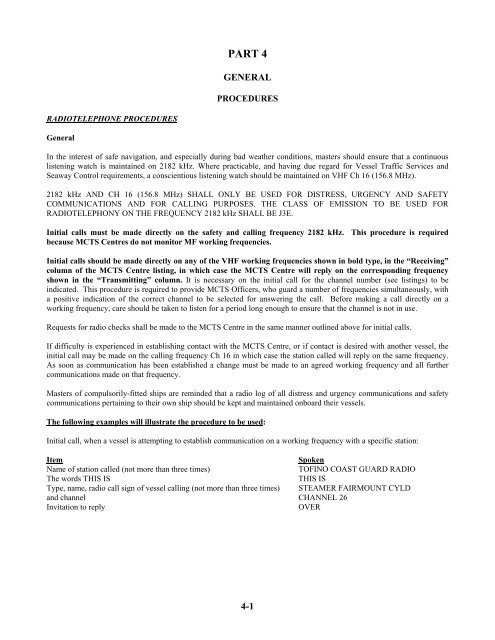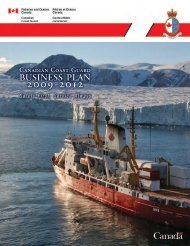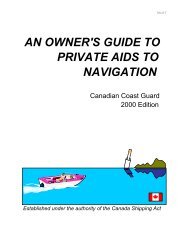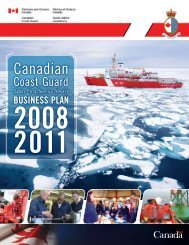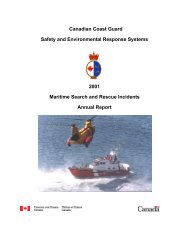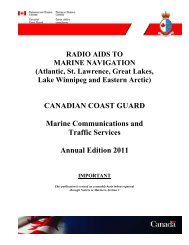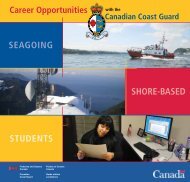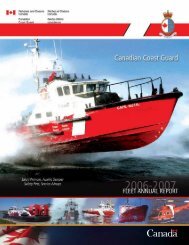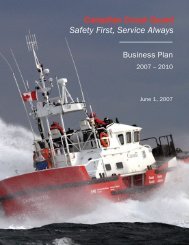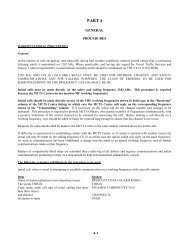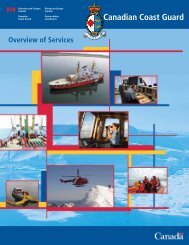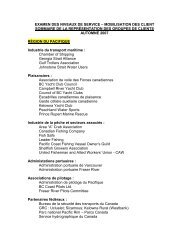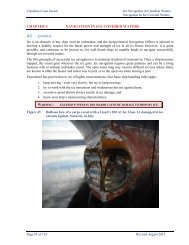RADIO AIDS TO MARINE NAVIGATION - Canadian Coast Guard
RADIO AIDS TO MARINE NAVIGATION - Canadian Coast Guard
RADIO AIDS TO MARINE NAVIGATION - Canadian Coast Guard
You also want an ePaper? Increase the reach of your titles
YUMPU automatically turns print PDFs into web optimized ePapers that Google loves.
PART 4<br />
GENERAL<br />
PROCEDURES<br />
<strong>RADIO</strong>TELEPHONE PROCEDURES<br />
General<br />
In the interest of safe navigation, and especially during bad weather conditions, masters should ensure that a continuous<br />
listening watch is maintained on 2182 kHz. Where practicable, and having due regard for Vessel Traffic Services and<br />
Seaway Control requirements, a conscientious listening watch should be maintained on VHF Ch 16 (156.8 MHz).<br />
2182 kHz AND CH 16 (156.8 MHz) SHALL ONLY BE USED FOR DISTRESS, URGENCY AND SAFETY<br />
COMMUNICATIONS AND FOR CALLING PURPOSES. THE CLASS OF EMISSION <strong>TO</strong> BE USED FOR<br />
<strong>RADIO</strong>TELEPHONY ON THE FREQUENCY 2182 kHz SHALL BE J3E.<br />
Initial calls must be made directly on the safety and calling frequency 2182 kHz. This procedure is required<br />
because MCTS Centres do not monitor MF working frequencies.<br />
Initial calls should be made directly on any of the VHF working frequencies shown in bold type, in the “Receiving”<br />
column of the MCTS Centre listing, in which case the MCTS Centre will reply on the corresponding frequency<br />
shown in the “Transmitting” column. It is necessary on the initial call for the channel number (see listings) to be<br />
indicated. This procedure is required to provide MCTS Officers, who guard a number of frequencies simultaneously, with<br />
a positive indication of the correct channel to be selected for answering the call. Before making a call directly on a<br />
working frequency, care should be taken to listen for a period long enough to ensure that the channel is not in use.<br />
Requests for radio checks shall be made to the MCTS Centre in the same manner outlined above for initial calls.<br />
If difficulty is experienced in establishing contact with the MCTS Centre, or if contact is desired with another vessel, the<br />
initial call may be made on the calling frequency Ch 16 in which case the station called will reply on the same frequency.<br />
As soon as communication has been established a change must be made to an agreed working frequency and all further<br />
communications made on that frequency.<br />
Masters of compulsorily-fitted ships are reminded that a radio log of all distress and urgency communications and safety<br />
communications pertaining to their own ship should be kept and maintained onboard their vessels.<br />
The following examples will illustrate the procedure to be used:<br />
Initial call, when a vessel is attempting to establish communication on a working frequency with a specific station:<br />
Item Spoken<br />
Name of station called (not more than three times)<br />
<strong>TO</strong>FINO COAST GUARD <strong>RADIO</strong><br />
The words THIS IS<br />
THIS IS<br />
Type, name, radio call sign of vessel calling (not more than three times) STEAMER FAIRMOUNT CYLD<br />
and channel CHANNEL 26<br />
Invitation to reply<br />
OVER<br />
4-1


